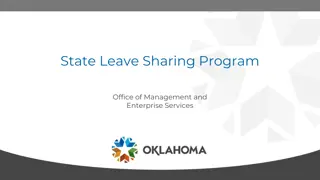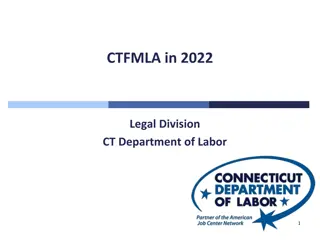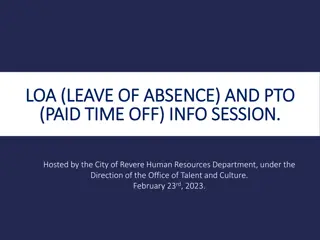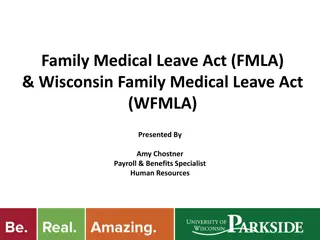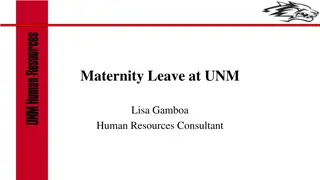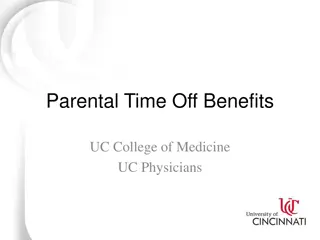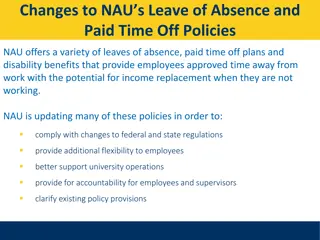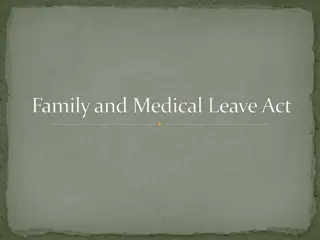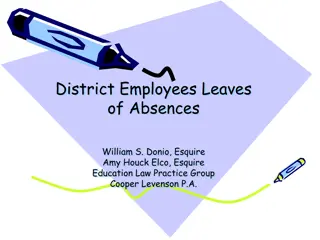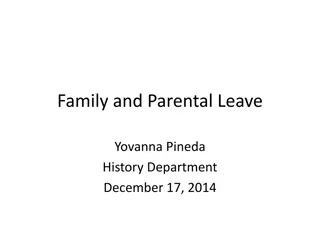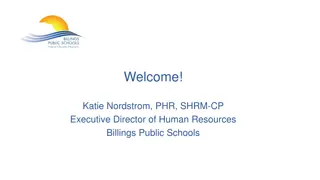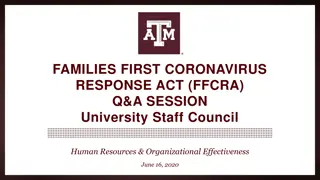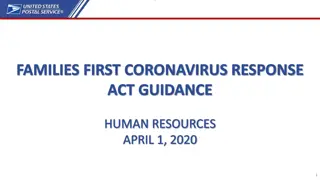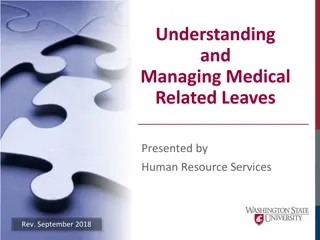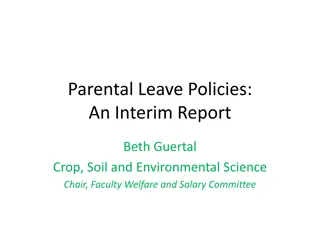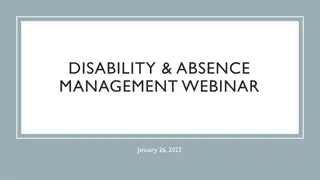FMLA - Family and Medical Leave Act Overview
The Family and Medical Leave Act (FMLA) provides unpaid, job-protected leave for specific family and medical reasons. Eligible employees can take up to 12 workweeks of leave in a 12-month period, allowing for bonding with a new child, caring for a family member with a serious health condition, taking medical leave for personal health issues, and addressing exigencies arising from a family member's military service. Employers must protect qualifying FMLA absences and ensure that returning employees are reinstated to their previous or similar positions. Learn more about FMLA eligibility criteria and usage by visiting the Department of Labor website.
Download Presentation

Please find below an Image/Link to download the presentation.
The content on the website is provided AS IS for your information and personal use only. It may not be sold, licensed, or shared on other websites without obtaining consent from the author. Download presentation by click this link. If you encounter any issues during the download, it is possible that the publisher has removed the file from their server.
E N D
Presentation Transcript
FMLA FAMILY AND MEDICAL LEAVE ACT
PLEASE NOTE THE FOLLOWING: The following slides are intended to provide general information regarding the FMLA and are not intended to provide individualized or legal advice concerning particular circumstances. Specific information regarding the FMLA is available on the Department of Labor website https://www.dol.gov/whd/fmla/
WHAT IS THE FMLA? Federal law designed to provide unpaid, job- protected leave for specified family and medical reasons FMLA may be taken all at once or intermittently as determined by an individual's physician FMLA entitles an eligible employee to 12 workweeks of leave in a 12-month period
FMLA PROTECTION Qualifying absences under FMLA cannot be considered by employers with regard to hiring, promotions, or disciple Protection to the extent that employee should be treated just as if working during qualifying FMLA absence Employees returning to work from FMLA must be returned to same (or nearly identical) job
WHO IS ELIGIBLE? TEAMS, Faculty, and OPS employees who have: Worked at UF for at least 12 months (need not be consecutive) AND Physically worked at least 1,250 hours in the 12 months prior to the start of leave (paid leave and unpaid leave, including FMLA leave, are not counted toward the 1,250 hours)
WHEN CAN AN ELIGIBLE EMPLOYEE USE FMLA LEAVE? for the birth of a son or daughter, and to bond with the newborn child; for the placement with the employee of a child for adoption or foster care, and to bond with that child; to care for an immediate family member (spouse, child, or parent but not a parent in-law ) with a serious health condition; to take medical leave when the employee is unable to work because of a serious health condition; or for qualifying exigencies arising out of the fact that the employee s spouse, son, daughter, or parent is on covered active duty or call to covered active duty status as a member of the National Guard, Reserves, or Regular Armed Forces. to care for a covered servicemember with a serious injury or illness.
WHAT IS A SERIOUS HEALTH CONDITION? A serious health condition under the FMLA is an illness, injury, impairment or physical or mental condition that involves: any period of incapacity or treatment connected with inpatient care (i.e., an overnight stay) in a hospital, hospice, or residential medical care facility; or a period of incapacity requiring absence of more than 3 calendar days from work, school, or other regular daily activities that also involves continuing treatment by (or under the supervision of) a health care provider; or any period of incapacity due to pregnancy, or for prenatal care; or
WHAT IS A SERIOUS HEALTH CONDITION? any period of incapacity (or treatment therefore) due to a chronic serious health condition (e.g., asthma, diabetes, epilepsy, etc.); or a period of incapacity that is permanent or long-term due to a condition for which treatment may not be effective (e.g., Alzheimer's, stroke, terminal diseases, etc.); or, any absences to receive multiple treatments (including any period of recovery therefrom) by, or on referral by, a health care provider for a condition that likely would result in incapacity of more than three consecutive days if left untreated (e.g., chemotherapy, physical therapy, dialysis, etc.)
UNABLE TO PERFORM THE ESSENTIAL FUNCTIONS OF A POSITION? Health care provider finds employee unable to work at all or unable to perform any one of the essential functions of position Employee must receive medical treatment Employee s condition makes him/her unable to perform some of the usual duties of the position
CONDITIONS NOT COVERED Unless complications arise, the following are NOT covered under FMLA: Common cold, flu, earaches, upset stomach, minor headaches Routine dental or orthodontic problems Other short-term voluntary treatments and immunizations unless they result in hospitalization
FMLA ENTITLEMENT Twelve of employee s regularly scheduled workweeks during 12-month period Entitlement is based on FTE Full-time employees (1.00 FTE) have maximum entitlement of 480 hours Part-time employees entitlement depends on FTE ex. .50 FTE equates to 20-hour workweek with maximum entitlement of 240 hours Important:UF s FMLA entitlement period is based on the fiscal year (July 1 to June 30)
USE OF ENTITLEMENTEMPLOYEES RESPONSIBILITY Provide employer with at least 30 days advance notice, when practical If FMLA leave is needed unexpectedly, inform employer as soon as possible Submit a completed Certification of Healthcare Provider for Employee's/Family Member's Serious Health Condition to Central Leave Indicate that leave is due to an FMLA-protected condition when notifying employer of absence (not necessary to tell the diagnosis or medical condition)
USE OF ENTITLEMENT FMLA is unpaid leave, however: Employees may use sick or vacation time while on qualifying FMLA leave so that they continue to be paid. They may supplement accrued leave with Leave Without Pay (LWOP), but must account for their entire FTE. Any leave designated as qualifying FMLA leave must be counted against FMLA entitlement
USE OF ENTITLEMENT When using approved FMLA-qualifying leave the employee may: Be completely absent (full day or workweek) Be absent from time to time or sporadically (intermittent leave) Work a reduced schedule on an ongoing basis (more to follow on next slide) Example: Full-time employee with 480 hours entitlement can reduce work to half time and take 24 weeks to use up entitlement hours.
REDUCED WORK SCHEDULES As long as employee is on approved medical leave, FTE should not be reduced in payroll system Reduced work schedules related to FMLA must be: Approved by Provost (if applicable to certain academic personnel). Supported by medical documentation
PAPERWORK REQUIRED FOR FMLA LEAVE Request for Extended Leave of Absence form FMLA Designation Notice form Certification of Health Care Provider form
FMLA-QUALIFYING LEAVE--ROLE OF THE SUPERVISOR/EMPLOYER Supervisors/employers must: Establish and follow a clear and uniformly applied policy regarding requirement for employees on leave to report in regarding status and intent to return Keep all FMLA-related information confidential Complete the appropriate forms for FMLA FMLA Designation form to indicate leave approved as FMLA Extended Leave of Absence form to indicate FMLA-eligible leave
FMLA-QUALIFYING LEAVE--ROLE OF THE SUPERVISOR/EMPLOYER Supervisors/employers must: Determine whether leave is for an FMLA-qualifying event when an employee requests leave or calls in sick Approve leave for FMLA-qualifying events unless employee has exhausted FMLA entitlement for year Advise employee that the leave is counted toward FMLA entitlement
FMLA-QUALIFYING LEAVE--ROLE OF THE SUPERVISOR/EMPLOYER Supervisors/employers must: Keep accurate records of FMLA entitlement Designate the leave as FMLA-qualifying Confirm payroll processor enters leave as FMLA- qualifying event & enters correct time reporting code Track an employee's use of the 12 work entitlement.
FMLA-QUALIFYING LEAVE--ROLE OF THE SUPERVISOR/EMPLOYER Supervisor/employer must NOT: Require employee to take more leave than is medically necessary or requested by employee Require employee to accept modified duties rather than take leave Note: Employees and supervisors should contact their HR satellite office or UF Benefits if there are questions regarding FMLA designation or procedures.
LEAVE BEYOND 12-WEEK FMLA ENTITLEMENT UF leave policy gives supervisors the option of approving up to 6 months of medical leave, under the UF Sick Leave Policy. This is an additional benefit, not required by FMLA. Exception: Parental Leave (TEAMS, USPS, Faculty) UF policy guarantees six months parental leave Supervisor must approve six months for parental leave even though FMLA only requires 12 weeks
DESIGNATING TIME AS FMLA-QUALIFYING Alternate Time Reporting Codes (TRCs) are used to reflect that employee s absence is FMLA-related: FSK (Sick) FAL (Vacation) FRC (Regular Comp) FSC (Special Comp) FLH (Without Pay) All absences due to Workers Comp injury/illness are FMLA- qualifying Overtime compensatory leave cannot be designated as FMLA- qualifying per federal law EXCEPTION: Can be used on FMLA leave to remain in pay status, but cannot be counted against an employee s entitlement
MEDICAL CERTIFICATION AND FITNESS FOR DUTY CERTIFICATION Medical Certification may be required for FMLA in the event of a serious health condition of the employee or immediate family member If required, certification must be provided within 15 days If an employee returns to work before the date indicated on the original Medical Certification, the supervisor must obtain formal communication from the healthcare provider that it is appropriate for the employee to return to work This Fitness for Duty Certification may also be required in other circumstances.
EMPLOYEE MEDICAL INFORMATION Human Resources, payroll processors, supervisors, etc., CANNOT directly contact health care provider(s) Employee medical forms should be submitted directly to UF Human Resources or an HR satellite office. For assistance with forms, contact your HR satellite office or UF Benefits by emailing central-leave@ufl.edu or calling (352) 392-2477
UF SICK LEAVE MAY APPLY TO NONFMLA MEDICAL SITUATIONS UF Sick Leave is not counted toward FMLA entitlement, unless sick leave is being used for approved FMLA leave For Example: Medical or dental appointments for employee or immediate family members For injuries or illnesses not considered serious health conditions, such as common cold, flu, earache, or upset stomach An illness of an immediate family member not covered by FMLA but covered by the UF Sick Leave policy Death of an immediate family member
MORE INFORMATION REGARDING FMLA University Benefits: Email Phone central-leave@ufl.edu (352) 392-2477 Department of Labor (DOL) FMLA website: https://www.dol.gov/whd/fmla/ DOL Employee Guide: https://www.dol.gov/whd/fmla/employeeguide.pdf




